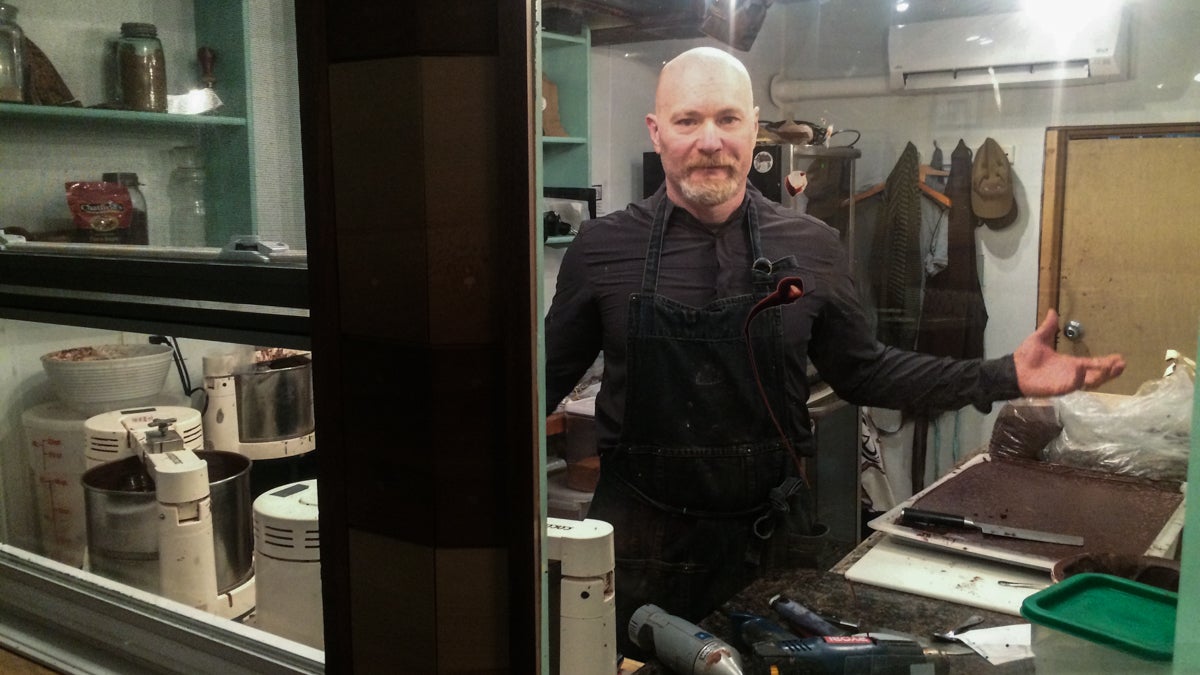Genomics leads chocolate farmers to hardy plants faster
Listen
Robert Campbell is known in Philadelphia as the chocolate alchemist. (Catalina Jaramillo/WHYY)
Growing cacao is difficult but scientists are trying out ways to make the process more efficient.
Robert Campbell makes chocolate in the dining room of his small Venezuelan restaurant, Sazon. After dinner, you’ll find him preparing one of his 20 drinking chocolates, and preaching the gospel of cacao as a fix for energy, nutrition and libido. In Philadelphia, he’s known as the chocolate alchemist.
“What I’m holding are the cocoa beans from Peru, these are Oro Verde,” Campbell said. ‘These have a nice reddish hue to them, they’re nice and healthy.”
Cocoa comes from cacao, a tree that produces pods full of beans that are fermented, dried and ground up.
The flavor of chocolate changes depending on the genes of the cacao, the environment where the tree grows, the way farmers process their beans, and the artistry of the chocolatier.
Campbell’s chocolate is low in sugar and intense in flavor.
“My style of chocolate is more like bourbon, more like scotch, more rum,” he said.
After tasting a piece, Campbell said: “Feel that kind of little stripe of sharpness? That scares people. I love it.”
Artisan chocolate makers like Campbell use heirloom cacao; they call it fine flavor chocolate. But many heirloom plants are old and susceptible to disease.
Multinational food and candy companies need lots of supply, so many farmers around the world have switched to modern plant varieties that are strong and productive.
One famous clone cacao variety is CCN-51, created by Homero Castro in Ecuador back in the 1960s. It’s popular, but Ed Seguine, a chocolatier and longtime advisor to the industry, says CCN-51 has one big problem.
“It tastes pretty bad. Actively bad,” Seguine said.
Still, these super varieties have been widely planted across the world, and today heirloom cacao only represent three to five percent of the global market, he said.
But it isn’t just fine flavor cacao that’s at risk. The whole cacao market is in a precarious situation. The World Cocoa Foundation reports that the production of cacao and the demand are growing at an equal rate. But that delicate balance can break at any moment, according to industry experts.
Big companies are pursuing new markets and people in places like India and China now have a taste for chocolate.
“There is a legitimate concern about the sustainability of the supply of cocoa today,” Seguine said.
“The main challenge that cacao growers are facing are various different plant diseases,” said Mark Guiltinan, professor of plant molecular biology at Penn State University’s College of Agricultural Sciences.
“They lose about 40 percent of the global crop, yearly, due to different plant diseases.”
Growing cacao is hard. Theobroma cacao, the tree’s botanical name, only grows in a relatively narrow band around the world: 15 to 20 degrees latitude north and south of the Equator.
Many trees are delicate, old and very susceptible to disease.
They are also sensitive to climate change and drought. They need the shelter and humidity of tropical rain forests.
“What we want to do is grow more cacao on the same or less land to provide for the demand,” Guiltinan said.
In 2010, Guiltinan and his colleagues were one of two science teams that sequenced the cacao genome. This year the National Science Foundation gave Penn State a $3.6 million grant to pinpoint genes that allow cacao to fight off disease.
“What we want to do next is provide breeders with that information so breeders use this knowledge to accumulate these important genes into a single new variety by traditional, conventional plant breeding,” Guiltinan said. “They just use the markers to speed up their job.”
In traditional breeding you cross two plants with desirable genes. Say one plan has disease resistant genes and the other plant has great productivity–you hope that some of the baby plants inherit both traits.
For cacao plants, the whole process of creating a new variety can take 20 years. Using DNA markers, breeders can know whether a new plant has inherited the desired genes by testing it as soon as it pops out of the ground. There’s no need to wait for the tree to grow and bear fruit—before you can taste test the beans.
Genomics can cut the waiting time in half. It’s conventional plant breeding — accelerated by science.
Guiltinan would love to go a step further – and use genetic modification to make the process even more efficient.
“Right now we are not creating GMO cacao for chocolate production because of the social hesitation surrounding this controversial technology,” he said.
Genetic modification allows breeders to introduce a single gene that comes from a different organism. With that tweak of DNA, cacao becomes able to fight diseases its own genes can’t fight.
For now, Guiltinan is keeping that experimentation to his lab. But he seems a bit frustrated.
“Eventually we’re going to see that GMOs are safe, and they can be done safely, and we can address all the concerns of society, and society will then embrace this new technology as much as we’ve embraced other technologies such as cars, and airplanes, and radios,” he said.
Ed Seguine is not so sure. He says chocolate is about passion and memories, and genetic modification shatters that romantic image.
“The consumer of the chocolate, that man or woman who has this candy bar or a bar of chocolate, they are the boss,” Seguine said. “They are the ones that overwhelmingly do not want anybody to mess with their chocolate. And that includes any genetic engineering.”
WHYY is your source for fact-based, in-depth journalism and information. As a nonprofit organization, we rely on financial support from readers like you. Please give today.



